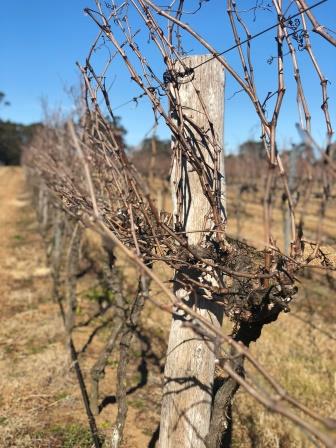Winter Musings
August 11, 2018 10:05 amAs we head through winter, we’re preparing to prune our vines at St Maur to be ready for spring. While there’s always something to be done in the vineyard, over the last months I have been doing a little research on tannins. I thought I would share some of the facts I uncovered in my reading with you.
Tannins are defined as “any of various soluble astringent complex phenolic substances of plant origin used especially in tanning leather and dyeing textiles, manufacturing ink, clarifying wine and beer, and in medicine.”
We’re not about to tan any leather or dye textiles at St Maur, yet. But when it comes to wine, you’ll recognise tannins as the element that makes a wine taste dry and adds to its character.
Wine tannins add bitterness and astringency, along with complexity to the wine. Commonly found in red wines, tannins are also present in some white wines, particularly those with a dry finish. You can experience the effect of tannins any time you drink a wine – they create the dry sensation in your mouth. Tannins are found naturally in different foods such as tea, nuts (almonds, walnuts etc.), dark chocolate, whole spices, beans, and quince, to name a few.
Wine tannins are generally derived from fermenting on grapes or aging the wine in oak barrels. Grape tannins come from the skins, seeds, and stems of the grapevine. For this reason, red wines have higher levels of tannins than whites, as the extended contact of the skins with the juice allows the tannins to dissolve in the alcohol and water of the wine. Wood tannins are derived from the wooden barrels wines are aged in. The most popular choice of timber for barrels is oak, due to the additional flavours such as vanillin they add to the wine. Oak also provides longevity, as the barrels can be used for up to 70 years in winemaking.
So the question we can ask is – “Are tannins good?”
Winemakers love tannins because they work as a natural antioxidant to protect the wine. This is a key reason why certain red wines age well since the tannins act as preservatives for the wines. The astringency from tannins also adds to the complexity of the wine’s flavours and provides a stronger finish.
Anti-oxidants are not only helpful to age wines but also deliver other benefits for wine drinkers. Tannins, by their very nature, react or interact with proteins and fats in animal and fats of foods. For example, when you eat steak with fat on it, and sip a tannin-heavy red wine (like a Cabernet Sauvignon), the tannin binds with the blood protein and the fat and causes them to seem less fatty, as they in turn bind with the tannin to make it seem less astringent or bitter.
The only downside to tannins is that they can cause some people headaches. A good way to test if you are prone to headaches because of tannins is to try foods that have strong tannins such as tea or dark chocolate and see they affect you. From my observations, many headaches after drinking wine are caused by over-consumption, however, if the headaches are due to tannins, it’s advisable to stick with wines that are low in them.
If you are interested in cellaring your wines for the long-term, do your research and select wines (especially red wines) heavier in tannins, as they should make the wine more suitable for aging.
I hope this helps inform you a little more on tannins – next time you are tasting red wines, see if you can identify if the wine is heavy in tannins by looking out for that dry/astringent characteristic.
The winds of August are already blowing in the vineyard, and the vines are calling to be pruned. I look forward to speaking with you all in Spring and seeing the vines come to life.
Until the next newsletter, stay warm, and enjoy a glass of your favourite wine.
-Salute Marco
This post was written by St Maur Wines


